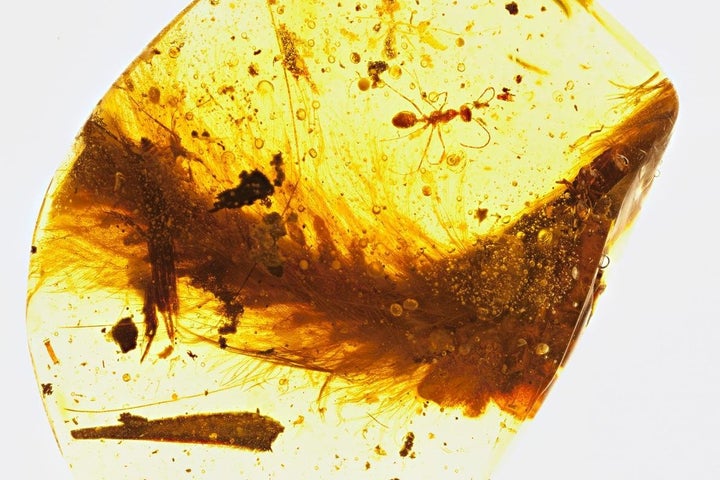
In a groundbreaking find, scientists have discovered the preserved tail of a tiny, 99-million-year-old feathered dinosaur.
The delicately feathered 1.4-inch tail with bone and tissue intact was frozen in time in a piece of amber originally discovered in a mine in northern Myanmar. It was eventually found last year at a street market by paleontologist Lida Xing of Beijing’s University of Geosciences.
“I never expected we could find a dinosaur in amber. This may be the coolest find in my life,” Xing told NPR.
“It’s a once in a lifetime find,” his research partner Ryan McKellar of Canada’s Royal Saskatchewan Museum told CNN. “The finest details are visible and in three dimensions.”
They’re believed to be the first-ever non-avian dinosaur feathers found preserved in amber, which are providing a fascinating glimpse into the early evolution of feathers and flight.
The feathers, brown on top with white undersides, cover eight vertebrae in the specimen dating to the mid-Cretaceous period. Because the bones are articulated, and not fused together as in modern birds, the creature was a dinosaur and not a prehistoric bird capable of flight, according to the scientists, who reported their findings in Current Biology.
The weak structure of the crude, early feathers that lack the interlocking architecture of ones developed up the evolutionary ladder was also not conducive to flight, according to the researchers. The feathers are missing a strong central shaft, known known as a rachis.
Instead of providing the capability of flight, the feathers, which likely covered the entire dinosaur, may have provided temperature regulation or some kind of signal, McKellar speculated to the National Geographic.
Scientists believe the tail belonged to a juvenile coelurosaur, part of the family of theropod dinosaurs related to Tyrannosaurus rex as well as others that developed into modern birds. Researchers have nicknamed the specimen Eva.
Intriguingly, tissue around the bones still held had traces of ferrous iron, the remains of hemoglobin from Eva’s blood. Eva was likely the size of a sparrow at death, but would have grown to the size of an ostrich had she lived.
Eva adds a key new piece to the feather puzzle.
“It’s a spectacular little glimpse,” McKellar told NPR. “It gives us, basically, a pathway that gets us to modern feathers.”
